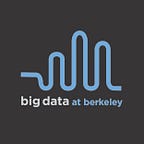Inspiring the Data Scientists of Tomorrow
When I was initially asked to lead the education team for Big Data at Berkeley, the goal for the education committee seemed simple enough. We wanted to develop and teach a bootcamp for high school students that would help them gain exposure and interest in data science. However, when we first started out, we often worried about whether it was feasible to properly introduce such a complex field in eight lessons. We wondered if we were capable of undertaking this responsibility, especially because data science was a relatively new field for us too. We decided to push these thoughts aside and focus instead on what made our own introductory experience in data science so memorable.
How I Got Started
Before I started my first semester at UC Berkeley, I enrolled in an introductory data science class, Data 8, without having any idea of what data science really is. After arriving at Cal, I was surprised to discover the immense scope and popularity of data science. Although I had never heard of the field before, it seemed to be everywhere around me. Data 8 was my first experience in learning both programming and statistics; I was completely new to both areas. Conventional wisdom would say that learning two complex disciplines simultaneously is setting yourself up for disaster. However, Data 8’s curriculum is centered around easing beginners into these areas, carefully guiding students through each topic. Within one semester, I had not only learned the fundamentals of statistics and coding in Python, but also understood how these skills can complement and build upon each other in data science. This class is one of my favorite classes I have taken, and this holds true for many of my peers as well. I believe its nearly universal appeal can be attributed to two main factors: the dedicated and passionate course staff and the accessibility for students of all backgrounds / skill levels. When developing the curriculum for the bootcamp, I made sure to incorporate these values which I found to be so essential to the success of Data 8.
The Bootcamp Experience
Since many of our students are beginners to both coding and statistics, it was crucial that we taught each topic in a captivating and innovative way. We didn’t want to spend the entire hour and a half just lecturing in a room full of disengaged students. Additionally, we wanted students to realize the relevance and impact of data science in the tech industry today. In order to tackle these issues, the education team works together to make our lessons more engaging. One way we do so is by creating unique activities that would reinforce what was taught. For example, one week we created a scavenger hunt in which the clues came in the form of Python code. Each clue directed the teams of students to a different location on our campus where they would then receive the next clue. It was an incredibly rewarding experience for everyone on the education team to watch the students enjoy solving and discovering new clues. Helping students enjoy learning data science is one of our primary goals whenever we prepare for and design lessons.
Another important aspect of the Big Data Bootcamp is making sure that it is accessible to as many students as possible from a variety of different experience levels and backgrounds. One of the simplest ways to ensure this is by making the bootcamp completely free for everyone and not requiring students to own a personal laptop to be admitted into the program. We want to limit financial barriers as much as possible. Additionally, when reviewing applications for the program, we focus on characteristics like enthusiasm and an eagerness to learn about data science, rather than an already expansive knowledge base. In doing so, we were able to have a diverse cohort of students for our Fall 2019 bootcamp. Many students had never learned coding or statistics before, while a few had some background in coding. In class, we encouraged everyone to collaborate with each other during the coding exercises. Our hope was that this would allow beginners to learn from their peers while more experienced coders could reinforce their knowledge. This semester, we expanded the number of classes offered to three since the main mission of this bootcamp is to reach as many students as possible.
Going Forward
Naturally, since Fall 2019 was the pilot semester for our bootcamp, there were a few hiccups along the way, such as technical difficulties and course pacing. Despite these obstacles, our first bootcamp was very successful and our entire education team really enjoyed having the opportunity to teach such a passionate and invested group of students. We all learned a lot from this experience as well and grew as teachers. Personally, I was relieved that I was able to lead this team to the best of my ability, thanks in large part to the incredible experience and ideas of everyone on the team. Going forward, as our bootcamp expands to reach more students, we also want to keep pushing ourselves to improve the bootcamp in any way we can. For example, we will be focussing on adding to the interdisciplinary nature of our curriculum. Since data science is an inherently interdisciplinary field, we want our students to recognize the potential it can have when applied to almost any area, from healthcare to entertainment. Additionally, we have added meetings dedicated to pedagogy as we want to maintain the quality of education as more instructors join our team. We are all very excited to continue playing our part in inspiring students to pursue such an innovative and essential field. After all, inspiring people is the ultimate goal of any educator.
